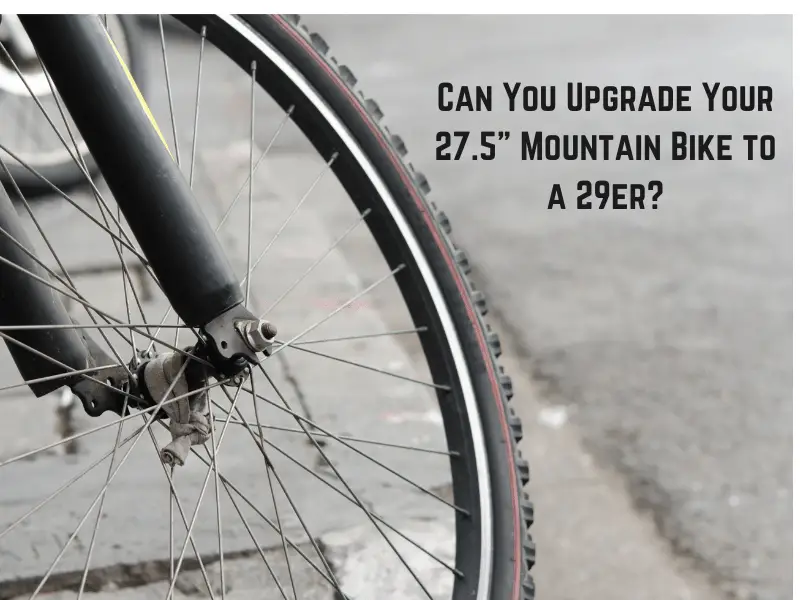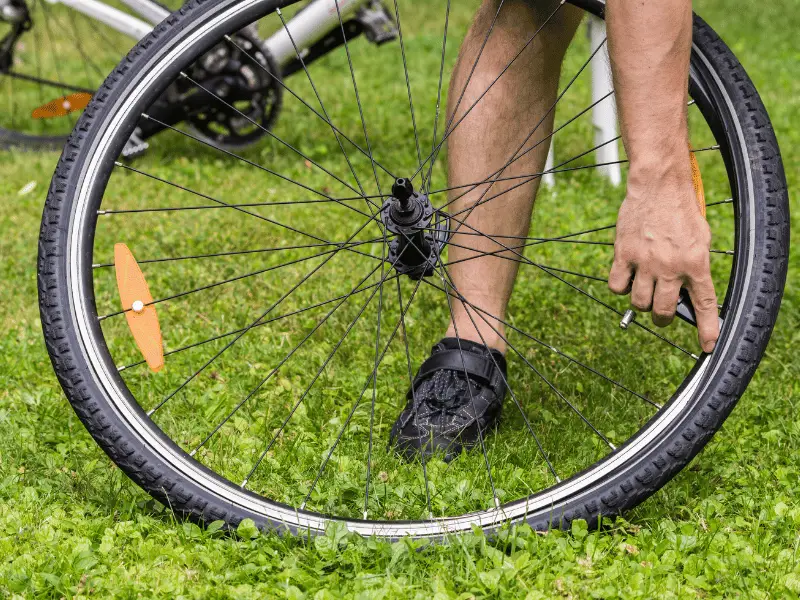
If you’ve been mountain biking for a while, you’ve probably heard the debate about wheel sizes. Some riders swear by the nimble and agile 27.5″ wheels, while others love the smooth and stable ride of the 29er.
But what if you already have a 27.5″ mountain bike and you’re curious about upgrading to a 29er? Can you simply switch out the wheels, or do you need a whole new bike?
In this post, we’ll explore whether it’s possible to change your 27.5″ mountain bike to a 29er and what you need to consider before making the leap. Let’s get started!
Understanding the Differences Between 27.5″ and 29er Wheels
When it comes to mountain bike wheels, there are two main sizes that dominate the market: 27.5″ and 29er. While both sizes have their strengths and weaknesses, they are quite different in terms of their ride characteristics and performance.
27.5″ wheels are often favored by riders who value agility, maneuverability, and a playful feel. These smaller wheels are generally lighter and more responsive than 29ers, making them ideal for technical terrain and tight corners. They also tend to have a lower center of gravity, which can improve handling on steep descents.
On the other hand, 29er wheels are known for their smooth rollover ability, stability, and speed. These larger wheels are better at carrying momentum and smoothing out rough terrain, making them ideal for cross-country riding and long, fast descents. They also tend to have a higher ground clearance, which can be beneficial on rocky or uneven trails.
Of course, these are generalizations, and the actual ride characteristics of a mountain bike depend on many factors beyond just wheel size. However, understanding the basic differences between 27.5″ and 29er wheels is an important first step in deciding whether to upgrade your bike. In the next section, we’ll explore whether it’s possible to switch out your 27.5″ wheels for 29ers.
Can You Upgrade Your 27.5″ Mountain Bike to a 29er?
Now that we’ve established the differences between 27.5″ and 29er wheels, the big question is whether you can upgrade your 27.5″ mountain bike to a 29er. The short answer is “it depends.”

One of the main factors to consider is the compatibility of your bike’s frame and fork with 29er wheels. Most modern mountain bikes are designed to accommodate both wheel sizes, but there are some older or lower-end models that may not be compatible. You’ll need to check your bike’s specifications or consult with a bike mechanic to determine whether your frame and fork can handle 29er wheels.
Another factor to consider is the compatibility of your bike’s components with 29er wheels. In particular, you’ll need to make sure that your brakes and drivetrain are designed to work with the larger wheels. This may involve upgrading to new brake calipers or adjusting your gearing to accommodate the larger wheel circumference.
Assuming your bike is compatible with 29er wheels, the actual process of upgrading is relatively straightforward. You’ll need to purchase a new set of 29er wheels, which may come with tires and tubes included. Once you have the new wheels, you’ll need to remove the old 27.5″ wheels and install the 29ers, making sure to adjust the brake calipers and derailleur as necessary.
However, even if your bike is technically compatible with 29er wheels, there are some potential downsides to consider before making the switch. In the next section, we’ll explore these potential drawbacks and benefits in more detail.
What You Need to Consider Before Making the Switch
While upgrading your 27.5″ mountain bike to a 29er may seem like a no-brainer for some riders, there are some potential drawbacks to consider before making the switch. Here are some key factors to keep in mind:
Weight:
29er wheels are generally heavier than 27.5″ wheels, which can make your bike feel less nimble and responsive. This can be especially noticeable during technical climbs and tight corners. Additionally, if you’re upgrading to wider tires to take advantage of the larger wheel size, you may also be adding additional weight.
Acceleration:
Due to their larger circumference and greater weight, 29er wheels can be slower to accelerate than 27.5″ wheels. This can make it more challenging to quickly get up to speed or change direction in technical terrain.
Fit:
Depending on your body type and riding style, a 29er bike may not fit you as well as a 27.5″ bike. For example, if you have shorter legs or a shorter torso, a 29er may feel too tall or long. This can affect your comfort and control on the bike and may require you to make additional fit adjustments or changes to your riding position.
However, there are also some potential benefits to upgrading to a 29er:
Roll-over ability:
29er wheels are better at rolling over obstacles like rocks and roots, thanks to their larger size and increased ground clearance. This can make technical terrain feel smoother and easier to navigate.
Stability:
The larger wheel size and longer wheelbase of a 29er can provide greater stability on descents and at high speeds. This can help you feel more confident and in control on the bike, especially on rough or uneven terrain.
Improved traction:
Wider tires are often used with 29er wheels, which can provide better traction on loose or slippery surfaces. This can be especially beneficial for riders who frequently encounter mud, gravel, or snow.
Ultimately, whether or not to upgrade your 27.5″ mountain bike to a 29er depends on your individual riding style, terrain preferences, and personal preferences. In the next section, we’ll explore how to actually upgrade your bike if you decide to make the switch.
How to Upgrade Your 27.5″ Mountain Bike to a 29er
Assuming you’ve decided to upgrade your 27.5″ mountain bike to a 29er, here are the steps you’ll need to follow:
- Check compatibility: Before you do anything else, make sure your bike’s frame and fork are compatible with 29er wheels. Check your bike’s specifications or consult with a bike mechanic to determine whether you can safely make the switch.
- Choose your wheels: Once you’ve confirmed compatibility, choose a set of 29er wheels that are appropriate for your riding style and budget. Consider factors like weight, rim width, and hub type when making your selection.
- Remove old wheels: Remove the old 27.5″ wheels from your bike. This typically involves loosening the quick-release skewer or removing the through-axle, then sliding the wheel out of the dropouts.
- Install new wheels: Install the new 29er wheels, making sure to line up the rotor with the brake caliper and properly seat the axle in the dropouts. Tighten the quick-release skewer or through-axle to secure the wheel in place.
- Adjust brakes: Adjust the brake calipers to accommodate the larger wheel size. You may need to adjust the position of the caliper on the mounting bracket, or simply loosen and re-tighten the caliper bolts.
- Adjust gearing: If you’re upgrading to a larger wheel size, you may also need to adjust your gearing to maintain proper chain tension and shifting performance. This may involve adjusting the position of the front derailleur or switching to a larger chainring.
- Test ride and adjust: Take your bike for a test ride to make sure everything is working properly. If you notice any issues with braking or shifting, make adjustments as needed.
Keep in mind that upgrading your bike to a 29er may require additional adjustments beyond the ones listed here. Depending on your bike’s components and compatibility, you may need to make changes to your suspension, tire size, or other parts to optimize your performance on the new wheel size. Consider consulting with a bike mechanic or experienced rider if you have any questions or concerns about the upgrade process.
Final Thoughts
In conclusion, upgrading your 27.5″ mountain bike to a 29er can be a worthwhile investment for some riders, but it’s important to consider the potential drawbacks and compatibility issues before making the switch.
If you decide to upgrade, follow the steps outlined above to ensure a smooth and safe transition. And remember, every rider is different, so don’t be afraid to experiment with different wheel sizes and setups to find the one that works best for you and your riding style. Happy trails!
